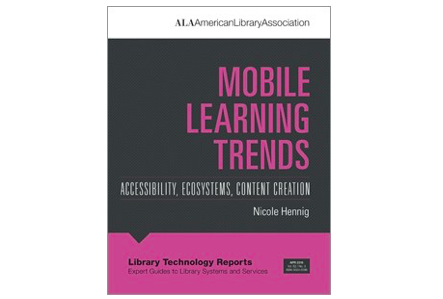Recently I wrote a technical report for ALA called Mobile Learning Trends: Accessibility, Ecosystems, Content Creation. Published in April of 2016, it focuses on three trends:
- Natural user interfaces and accessibility
- Multi-device ecosystems
- Content creation with mobile devices.
There are synergies between these trends that offer opportunities for those who care about access for all. This report includes ideas for how libraries can use this information to empower their users, and resources for learning more.
Table of Contents
Chapter 1: Natural User Interfaces and Accessibility

NUI = natural user interface
- Natural user interfaces are making computing easier for all ages and abilities
- Putting the Human before the Computer: The Move from “GUI” to “NUI”
- Types of NUIs
- Why everyone should pay attention to matters of disabilities
- Types of disabilities
- Stories of people whose lives are improved by the use of mobile technologies
- Examples of NUIs
- Touchscreens and Multi-touch Gestures
- Haptic Interfaces
- 3D Touch and Force Touch
- Speech Recognition in a Dictionary
- Reading Aloud for Children
- Reading Aloud for All Ages
- Audio Wayfinding for the Blind
- Conversational Interfaces: Talk with Your Device
- Smart Hearing Aids, Controlled with Apple Watch
- Smart Hearing and Augmented Hearing. Smart Listening Features for Headphones
- Camera as Seeing Eye for Language Translation
- Camera as Seeing Eye for Tree Identification
- Camera as Seeing Eye with Currency Recognition for the Blind
- Camera as Scanner
- Augmented Reality for Understanding Chemistry or Human Anatomy
- Summary
This chapter discusses the rise of “NUIs” (natural user interfaces), and shows how this development is leading to easier computing for all ages and abilities. It defines NUIs and gives examples of them in the areas of touch, sound, and sight. It covers touch screens, speech recognition, conversational interfaces, augmented reality, and several other types of NUIs.
It discusses why it’s important for everyone to make their services inclusive for people of all abilities. It looks at several types of disabilities and gives examples of how people’s lives are improving with the use of mobile devices and natural user interfaces.
Chapter 2: Multi-Device Ecosystems

- Multi-device ecosystems are making computing more convenient
- Cloud services and the Internet of Things
- Three ways that devices can work together
- Examples: consistent design, continuous design, complementary design
- Summary
This chapter discusses and defines multi-device ecosystems. It looks at how mobile and desktop computers work together, along with other types of hardware, such as wearables and smart TV.
It defines three ways that devices work together: consistent, continuous, or complementary design. It shows examples of each type of multi-device experience and how it’s being used to improve learning experiences for all ages and abilities.
Chapter 3: Content Creation with Mobile Devices

- Mobile devices are making it easier to create
- Libraries Facilitating Creation
- Active Creation as the Best Way to Learn
- Mobile Devices for Content Creation
- Types of content creation
- App Smashing—Using Multiple Apps in Succession
- Examples of creating with mobile apps: visual arts, text and multimedia, music and sound, 3D printing
- Summary
This chapter focuses on content creation with mobile apps. It discusses why active creation is an excellent way to learn. It includes examples from the visual arts, text and multimedia, music and sound, and 3D printing.
It ties together information from the previous chapters about multi-device experiences for content creation, and gives examples of creating with mobile apps by people with specific disabilities.
Chapter 4: Opportunities for Libraries

- Opportunities for Libraries
- Create Guides, Online and in Print, That Recommend the Best Mobile Technologies
- Offer Workshops on How to Use These Technologies
- Provide Devices That People Can Use Together with Their Own Smartphones or Tablets, Such as Large Screens, Smart TV Systems, or Amazon Echo
- Support Training for Your Staff in These New Technologies
- Questions to consider
- How Can We Bring These Technologies to Those Who Can’t Afford Them?
- What Are the Ramifications for Privacy and Security?
- How Can We Keep Up with Understanding These New Technologies?
- Continue Your Learning: books, articles, websites, online courses, and newsletters.
This chapter offers several ideas for using knowledge of these mobile trends in library programs and services, including guide-creation, workshop offerings, hardware suggestions, and staff training.
It also includes some questions to consider about the digital divide, privacy, and staying current. It offers recommended resources for continuing your learning with books, articles, websites, and online courses.
Buy the report from the ALA Store.
More books on mobile technologies
If you’re interested in keeping up with the best mobile technologies, take a look at my publications on mobile technology for librarians and educators.
